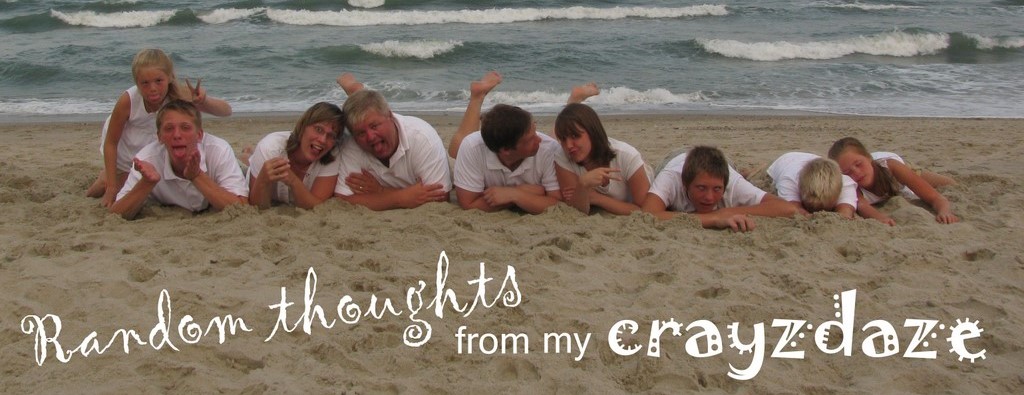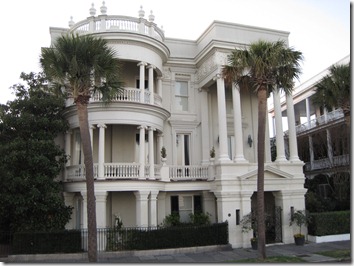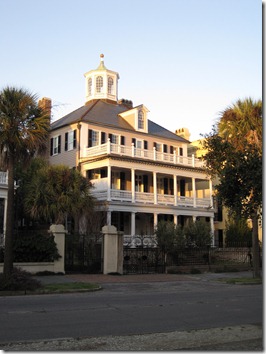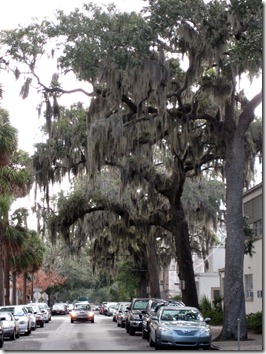Here’s my little history lesson from last week—what I gleaned from our trip and have learned since.
Charleston was founded in 1670. The first city was on the Ashley River and called Charles Town. They settled on the Ashley (on the southern side of the modern city) because it was a shallow river and the settlers thought that Spanish warships wouldn’t be able to get at them there. Ten years later they relocated the city to the peninsula where it is today, between the Cooper and Ashley Rivers. The Cooper River is very deep and the port at Charleston is the 5th busiest port in the US.
It’s obvious as you walk around historic Charleston that there was a LOT of money there. Much of this money came from three commodities—cotton, rice, and slaves. Many wealthy plantation owners built lavish town homes in Charleston and we had a great time looking at them.
Charleston was affected by both the Revolutionary War and the Civil War. In 1776 Charleston was attacked by the British but the British were unable to take the city. Four years later the British attacked again and Charleston was under siege for 6 weeks before being defeated. It was considered one of the greatest American defeats of the Revolutionary War.
In April of 1861 the Civil War was started with the attack on Fort Sumter in Charleston Harbor. In 1863 the Union attacked a nearby fort and shelled Charleston regularly for the next 545 days. (And nights.) We were interested to learn that the cannon balls did more damage because of their size and weight than their explosive capability. Many unexploded shells have been found over the years, including one in a church steeple and one under the foundation of an elementary school!
In 1886 Charleston was nearly destroyed by an earthquake that is estimated to have been about 7.5 on the richter scale. (The earthquake was felt in Chicago, Boston, and Cuba!) It damaged 2000 buildings in Charleston. Buildings that could be salvaged were repaired using long iron rods. The iron rods were run through the walls and anchored on the outside with things that look like huge washers & bolts. You can see them here on the side of this building.
(Do you see the blue sky in that picture? Something tells me we’re not going to experience many January days that look like that in Oregon…)
Savannah has also had a long and colorful history. It was colonized in 1733 to offer a new start for England’s working poor. The colony of Georgia was also supposed to act as a buffer zone for South Carolina, protecting it from the Spanish living in Florida.
Savannah originally had several prohibitions—rum, lawyers, and slavery.
General Oglethorpe planned the city as a series of grids containing blocks for residences, blocks for business, and public squares or parks. Quite progressive of him, I’d say!
The British captured Savannah during the Revolutionary war and held it for four years. After the war farmers discovered that the climate was great for growing cotton and rice, so Georgia legalized slavery. Many slaves were brought in through Savannah’s port as well. The cotton gin was actually invented in Savannah by Eli Whitney, a local tutor.
As I mentioned before, Savannah had several terrible fires and in 1820 ten percent of the population died from yellow fever.
During the civil war there were sea blockades that were so effective that they destroyed the economy in Savannah. The city itself didn’t fall until Sherman entered in mid-December of 1864. The Confederate forces had escaped on pontoon bridges the night before, so Sherman entered the city without any fighting. He was so impressed with the beauty of the city that he decided not to destroy it. (Clearly he had not seen the Thunderbird Inn!) Instead he sent a telegram to President Lincoln on December 22nd, offering the city to him as a Christmas present.
I wonder if the tree lined streets had as much Spanish Moss then as they do now?
And just for your information, spanish moss is neither spanish nor moss. Instead it is an “air plant” related to pineapples!
The port of Savannah is the 4th busiest port in the US now, and we were lucky enough to see a container ship coming up the Savannah river. The size was staggering—I counted 8 flights of stairs above the level of the deck. It was so long that it had to get quite a ways past us before I could fit it all in one picture. [I just read that some of the container ships are as long as 75 story buildings!]
It was followed by a couple of tug boats, though we weren’t sure if they were there as a precaution or if they were actually going to help.
We loved watching the ship go towards the Savannah River Bridge—the perspective was very entertaining.














I'm sure enjoying your history lessons! I especially love the pictures accompanying the descriptions. Thanks for sharing it here. =)
ReplyDeleteMy mom always told me that the real reason Sherman didn't burn Savannah was because he had a "lady friend" who was from the city. Whatever the reason, I'm glad they're both still around! We will definitely have to make a farewell visit to Chas. before we leave here.
ReplyDeleteYou may not see blue skies in Jan., but there will be lots in the summer. And in Jan you'll have the emerald green foliage to cheer you up:).
I just love the architecture of that place! It does make me miss the south :)
ReplyDelete